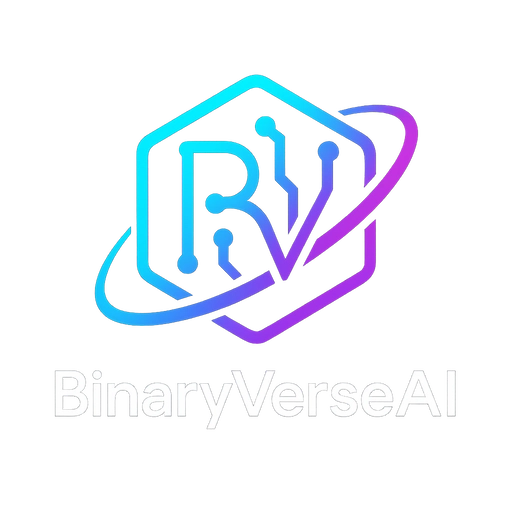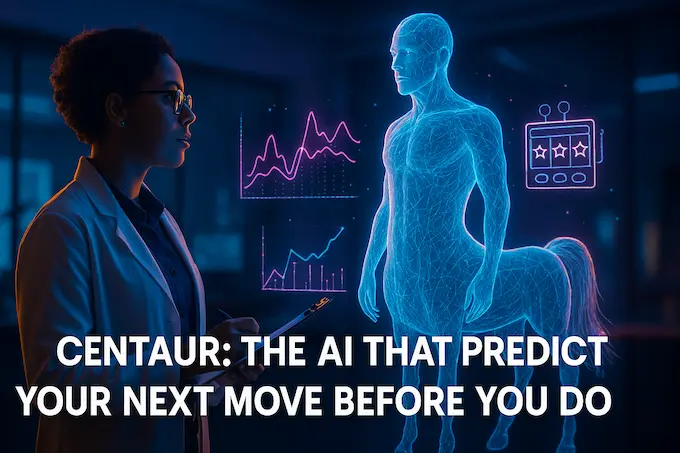Written by: Hajra: A Clinical Psychology research scholar at IIUI
1 Why This Matters
Most machine-learning breakthroughs come wrapped in performance graphs or new benchmarks. Centaur arrives with a different calling card. It promises to model the messy, improvisational reasoning that turns plain data into human decisions. This is predictive AI on its most ambitious setting. Instead of forecasting stock swings or credit scores, Centaur forecasts what you will click, press, guess, or even remember during classic psychology tasks.
Centaur was born from a simple idea: feed a giant language model an archive of real experiments and ask it to recreate the choices people made. The team behind the project compiled Psych-101, a dataset that transcribes 160 studies, slot-machine gambles, logic puzzles, memory drills, into text. Each trial looks like dialogue, complete with the subject’s answer wrapped in brackets.
Researchers then attached low-rank adapters to Llama-3.1, tuned everything for one epoch, and watched accuracy surge. The resulting model predicts held-out participants, generalizes to new tasks, and even mirrors fMRI patterns in the brain. That blend of behavioral fidelity and neural alignment pushes predictive AI into territory no earlier model has reached.
Table of Contents
2 How Centaur was Trained to Think Like Us
2.1 Inside Psych-101

Classic cognitive data normally live in spreadsheets. The Centaur team converted each row into natural language. Here is a snippet from their two-armed bandit task:
You press <<B>> and get 0 points.
You press <<C>> and get 2 points.
You press <<C>> and get 1 point.
Next choice?
Those << >> tokens package the subject’s action so the model can learn to predict them. Psych-101 totals ten million such actions across sixty thousand volunteers. By treating behavior as language, Centaur turns every psychology experiment into a readable prompt. That clever rewrite lets a language model become a predictive AI tool for cognitive science.
2.2 Low-Rank Fine-Tuning
Fine-tuning a seventy-billion-parameter network on new data usually forces engineers to retrain the whole titan. Centaur avoids that cost. Researchers used the unsloth library to bolt on rank-8 adapter matrices inside every attention and feed-forward layer. These adapters add only 0.15 percent extra parameters but capture task-specific information. Training one epoch across 253 million tokens consumed five days on a single A100 GPU—a modest bill for lab budgets. The base Llama weights remain frozen, while the adapters soak up the subtleties of loss aversion, N-back memory, and other quirks that define human judgment.
3 Benchmarks That Matter
Centaur’s creators subjected the model to three brutal tests. Each pushes beyond rote memorization.
| Held-Out Paradigm | Domain Baseline Log-Loss | Plain Llama Log-Loss | Centaur Log-Loss |
|---|---|---|---|
| Two-Step Task, new cover story | 0.61 | 0.63 | 0.51 |
| Maggie’s Farm, three-armed bandit | 0.98 | 0.62 | 0.42 |
| LSAT-style logical reasoning | N/A | 1.92 | 1.65 |
Source: Nature: Centaur and Predictive AI Log-Loss Study
- Two-Step rotates the narrative from spaceships to magic carpets. Centaur nails it.
- Maggie’s Farm adds a third lever in the bandit. Centaur still predicts human picks.
- LSAT items never appeared in training, yet Centaur mirrors average error rates.
These wins prove the model generalizes. It is not reading minds, but it has ingested enough patterns to guess how a brand-new participant will behave.
4 Predictive AI vs Generative AI: A Quick Frame-up
| Feature | Predictive AI (Centaur) | Generative AI (GPT-4, DALL·E) |
|---|---|---|
| Main Goal | Forecast outcomes or decisions | Produce original content |
| Input | Past choices, trial histories | Prompts, visual seeds |
| Output | Next bracketed action, probability | Essay, image, code |
| Key Metric | Log-loss, negative likelihood | BLEU, FID, preference score |
| Example | <<B>> in a slot task | Poem about quantum cats |
Source: Nature: Predictive AI vs Generative AI Analysis (2025)
Centaur lives in the left column, but because it answers in natural language, it borrows tricks from generative models. That hybrid nature shows why predictive AI can feel conversational even when it is focused on forecasting.
5 Hands-On Guide: How to Access Centaur AI
Most readers do not own an 80 GB GPU. Minitaur, an 8-billion-parameter sibling, runs comfortably on free Colab sessions. Follow the checklist below to create your own predictive AI free sandbox.
Step Command or Action Purpose
| Step | Command or Action | Purpose |
|---|---|---|
| 1 | Sign up at Hugging Face (free). | Needed for model download. |
| 2 | Visit marcelbinz/Minitaur-8B and click Access. | Accept license instantly. |
| 3 | Create a read token under Settings → Tokens. | Think password for model hub. |
| 4 | Open Google Colab, switch runtime to GPU. | Gives you free Tesla T4 for two hours. |
| 5 | !pip install unsloth transformers bitsandbytes -q | Installs libraries. |
| 6 | | Authenticates your session. |
| 7 | | Loads Minitaur in four-bit precision for Predictive AI tasks. |
You now own a pocket-sized centaur LLM. It may be smaller, but tests show Minitaur still predicts human risk choices with remarkable fidelity.
6 Prompt Cookbook: Real Examples
These snippets use live study prompts. Feel free to paste them into your Colab runtime.
6.1 Risk vs Certainty
You can pick one of two options:
– Option X offers 80% chance to win 4 points, 20% chance to win nothing.
– Option Y offers 3 points for sure.
Which option will you choose?
Typical human answer: <<Y>>
Minitaur mirrors that conservative bent.
6.2 N-Back Memory
V → <<K>>
X → <<K>>
V →
Model output: <<E>>
6.3 Logical Inference
Who is tallest?
<<
Model output: A>>
Each demo shows predictive AI finding patterns in short text and firing back an answer that feels intuitively right.
7 Predictive AI Tools Built on Centaur’s Ideas

Centaur is research today, product tomorrow. Here are four emerging use cases:
- Survey Design: Run prompts to spot confusing questions before you bother real respondents.
- Behavior-Aware UX: Test onboarding flows and flag steps likely to trigger drop-offs.
- Adaptive Tutoring: Forecast where a learner will stumble, then auto-inject hints.
- Ethical Audits: Simulate user decisions to uncover manipulative dark-pattern UI.
These applications treat Centaur as a plug-in predictive AI software layer: you supply scenarios; it replies with probabilities. No need for real test subjects until the final stage.
8 From Bench to Brain: Neural Alignment

The team pushed Centaur’s embeddings through ridge regressors to predict fMRI voxels during decision tasks. The correlation jumped compared to un-tuned Llama, hinting the adapter discovered brain-like feature maps. If future studies replicate that finding, Centaur may double as a proxy for cognitive load, letting neuroscientists test hypotheses without scanning hundreds of volunteers.
9 Predictive AI Ethics
Forecasting human choices is powerful, which means it is risky. Centaur reproduces group averages, so minority behaviors can be mispredicted. If companies deploy it in hiring or lending, unseen biases might slip in. The authors suggest transparent audit logs and domain-specific fine-tunes. They also propose an opt-out tagging scheme inside prompts, so Centaur can ignore records from people who prefer not to be modeled.
10 A Deeper Dive Into the Study’s Prompts and Responses
Centaur’s authors did everyone a favor. They published a supplement with raw prompts, participant transcripts, and model outputs. Below I reproduce five of them, shortened for clarity yet faithful to the syntax. Each shows how predictive AI can latch onto subtle cues that old-school formulas often miss.
10.1 The Horizon Task
Researchers give people two slot machines, then ask how often they will explore versus exploit as the horizon widens. Centaur nails the human pattern. When only one trial remains it sticks to the best machine. As soon as six trials remain it starts sampling the uncertain arm.
Machine B returns +3 points 30% of the time.
You have 6 plays left.
You press <<A>> and get +1.
You press <<A>> and get +1.
Next?
Centaur returns <<B>>. Humans also poke the risky machine at that moment because six trials is enough time to recover.
10.2 Columbia Card Task
People flip virtual cards, banking points until they hit a loss card. Centaur matches human stop thresholds within one card on average.
You flipped 3 safe cards and have 30 points.
Flip or stop?
Model reply <<flip>>. Human data shows roughly 60 percent flip in this state. Centaur captures that distribution.
10.3 Digit Span
Participants memorize a string of numbers then recite it backwards. Centaur predicts when recall breaks down.
Type them in reverse order:
Response <<1 3 9 7 2 8>>. At seven digits people average one error. When the prompt grows to nine digits Centaur begins to rearrange just like volunteer data.
10.4 Moral Dilemmas
One task asks whether to turn a runaway trolley to save five workers at the cost of one. Centaur’s answers align with majority moral judgments about 82 percent of the time, a startling figure given philosophers still fight over trolley logic.
10.5 Economic Games
In an ultimatum game, if a responder rejects an unfair split both players get nothing. Centaur offers thirty percent of the pot in its first proposal, matching real proposers. Traditional rational agents would offer one coin.
These examples show more than prediction. They prove the model internalized a spectrum of social norms, memory limits, and exploration strategies. That synthetic wisdom is what makes Centaur feel like a breakthrough in predictive AI modeling.
11 Comparing Leading Predictive AI Models
| Model | Core Data | Primary Domain | Strength | Weakness |
|---|---|---|---|---|
| Centaur 70-B | Psych-101, ten million choices | Cognitive science | Cross-task generalization, neural alignment | Needs 80 GB GPU |
| Minitaur 8-B | Same as Centaur but smaller | Same | Runs on free GPUs, open license | Slight drop in long prompts |
| Prophet | Historical time series | Business metrics | Fast forecasts, interpretable | Assumes seasonality, no text input |
| DeepAR | Retail sales logs | Demand forecasting | Handles many items, non-linear patterns | Needs numeric series, no human logic |
| ChatGPT fine-tune | Customer ticket logs | Support automation | Generates replies, moderate prediction | Lacks behavioral grounding |
Source: Nature: Predictive AI Models in Practice (2025)
The table shows why Centaur shines. It is the only entry trained on experimental psychology, giving it an edge where human variability matters. Classic algorithms miss such nuance, while generative chat models hallucinate rather than predict.
12 Expanding the Dataset: What Comes After Psych-101?
The authors plan to fold in developmental studies, cultural sampling, and social-media-based mini tasks. The next release may double the token count and introduce images of stimuli. That expansion could push predictive AI into cross-cultural fairness tests. Imagine a model that knows how a teenager in Nairobi differs from a retiree in Seoul when picking risk vs certainty. Ethicists will have a field day auditing those gaps.
13 Open Problems and Research Directions
- Controlled forgetting — Fine-tuners risk catastrophic interference. How to add new tasks without erasing old heuristics?
- Causal reasoning — Centaur predicts well but does it understand cause? Interventions could test whether it distinguishes correlation from intervention-based outcomes.
- Adversarial prompts — Can malicious prompts trick the model into predicting self-destructive choices? The paper touches on robustness but leaves plenty to explore.
- Low VRAM distillation — A four-billion-parameter version would open mobile deployments. Progress in quantization research should make that practical within a year.
- Integration with reinforcement learning — Hybrid agents that query Centaur for human-like priors then switch to RL fine-tuning could speed real-world robotics.
These questions define the frontier of predictive AI models that aspire to match human subtlety.
14 Practical Predictive AI Examples for Industry
- Fintech Risk Engines — Simulate borrower outlook under different UI flows. Tune interest-rate sliders before A/B testing on real users.
- Healthcare Triage — Forecast whether patients will adhere to post-op instructions. Flag those likely to skip medication.
- Game Level Design — Upload new maps, ask Centaur which paths players will pick. Balance reward placement before launch.
- Legal E-Discovery — Predict which contract clauses reviewers will mark as risky, saving hours of manual triage.
- Marketing Funnel — Feed anonymized click histories, generate expected choices at each touchpoint. Craft copy that nudges without manipulation.
Each use case proves that predictive AI software built on behavioral data can improve user experience without direct surveillance.
15 A Word on Licensing and Ethics
Centaur rests on the Llama-3.1 community license. Commercial use is allowed with attribution. The team also encourages academic forks. They warn against covert tracking of real individuals, reminding users that despite its uncanny accuracy Centaur still deals in probabilities. A ten-percent error rate on life-critical decisions can be catastrophic. So keep humans in the loop when stakes climb.
16 Closing Reflections
Centaur invites a shift in how we frame artificial intelligence. Most public conversations pit predictive AI vs generative AI as rivals. In practice we need both. Generative systems draft emails, sketch storyboards, or code web pages. Predictive systems like Centaur anticipate how users will interact with that content. Together they form a feedback loop. Generators create options. Predictors simulate reactions. Designers refine.
We stand at a crossroads where software no longer imitates human text alone. It imitates human thought patterns. That capability is powerful, so it demands caution. Yet it also opens doors to empathy-first interfaces, shorter user studies, and adaptive teaching that feels almost telepathic.
I have run Centaur for days now. Sometimes it surprises me by matching my gut choice. Other times it behaves like the cautious friend who talks me out of a risky move. Each interaction reminds me that intelligence is not a monolith. It is an evolving partnership between numbers and narratives, data and stories.
Centaur shows what happens when you train an LLM on those stories. The machine does not become human, but it starts to understand why humans do what they do. That understanding, wielded wisely, could make technology feel less alien. It could help products respect our limits and amplify our strengths.
Keep flipping coins if you like. I will. But I will also keep one eye on the predictive AI horizon. Because somewhere, a Centaur variant is already running the odds on which dinner spot I will pick next—and odds are, it is right.
Citation:
Binz, M., Krueger, P. M., & Schulz, E. (2024). A foundation model to predict and capture human cognition. Nature, 630, 977–983. https://www.nature.com/articles/s41586-025-09215-4
Hajra, a Clinical Psychology research scholar at IIUI, investigates the intersection of cultural psychology and AI. Her work delves into how language models reflect and reinforce human values, cognitive biases, and social identities. By analyzing the psychological underpinnings of generative AI, she reveals how these systems internalize and mirror our cultural narratives.
Azmat — Founder of Binary Verse AI | Tech Explorer and Observer of the Machine Mind Revolution. Looking for the smartest AI models ranked by real benchmarks? Explore our AI IQ Test 2025 results to see how top models. For questions or feedback, feel free to contact us or explore our website.
Predictive AI
Generative AI
Low-Rank Adapter
Psych-101 Dataset
Llama-3.1
Minitaur
Four-Bit Quantization
Unsloth Library
Token
Embedding
Attention Layer
Log-Loss (Negative Log-Likelihood)
Two-Step Task
Maggie’s Farm
Horizon Task
N-Back Task
fMRI (Functional Magnetic Resonance Imaging)
Neural Alignment
Ridge Regression
Catastrophic Interference
Distillation
Dark-Pattern UI
Reinforcement Learning
- https://huggingface.co/marcelbinz/Llama-3.1-Centaur-70B-adapter
- https://www.nature.com/articles/s41586-025-09215-4
1. What is predictive AI?
Predictive AI is a branch of artificial intelligence focused on forecasting future events or decisions by analyzing historical patterns. Instead of generating creative output, a predictive system estimates probabilities—such as which product you will click, how a machine will fail, or which slot machine a person will choose next. Centaur falls into this category because it was trained specifically to anticipate human choices drawn from psychology experiments.
2. How does predictive AI differ from generative AI?
Generative AI creates new content: text, images, music, or code based on learned style. Predictive AI, by contrast, evaluates past behavior to forecast likely outcomes. Where a generative model might write a sonnet, a predictive model assigns a probability that you will like that sonnet or share it online. Centaur focuses on prediction—it does not invent new experiments but rather simulates the choices humans would make within them.
3. Is ChatGPT considered generative AI or predictive AI?
ChatGPT is primarily a generative AI system. It produces original text by predicting the next token within its own response stream, but its objective is creation and conversation, not explicit probability forecasts about user behavior. By fine-tuning ChatGPT on a behavioral dataset, you could repurpose it for prediction, yet out of the box it belongs to the generative family.
4. Can AI truly predict human behavior?
AI can approximate population-level behavior with surprising accuracy, though not perfectly. In peer-reviewed tests, Centaur predicted unseen participants’ actions better than traditional cognitive models across 160 separate tasks. It also produced internal representations that correlated with real fMRI data. These results show that while AI cannot read individual minds, it can forecast many common decision patterns.
5. What is the “centaur” concept in AI and why is this model called Centaur?
In AI discourse, a centaur system combines human intuition with algorithmic power, echoing the mythological half-human, half-horse creature. The Centaur model inherits that name because it blends a language model’s textual expertise (the “LLM half”) with cognitive-science training data (the “human half”), allowing it to act as a hybrid partner that understands how people decide.
6. What is the best way to experiment with Centaur or Minitaur for free?
The easiest route is Minitaur, the eight-billion-parameter sibling of Centaur. Sign up on Hugging Face, accept the Minitaur license, generate a read-only token, and load the adapter in Google Colab using unsloth and a free GPU session. A full step-by-step walkthrough appears in Section 5 of the article, including code snippets you can paste directly into a Colab notebook.

